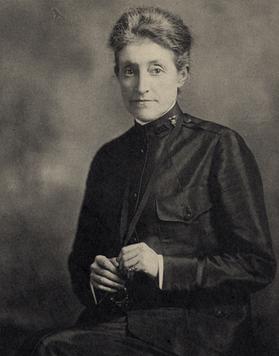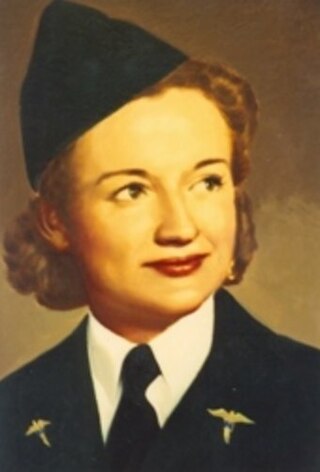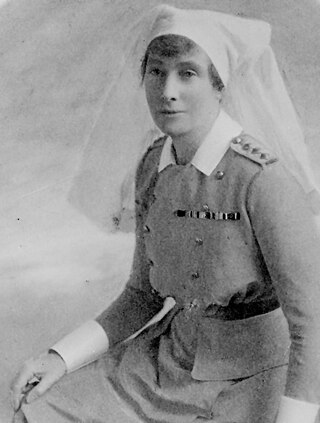Related Research Articles

Uniformed Services University of the Health Sciences (USU) is a health science university and professional school of the U.S. federal government. The primary mission of the school is to prepare graduates for service to the U.S. at home and abroad as uniformed health professionals, scientists and leaders; by conducting cutting-edge, military-relevant research; by leading the Military Health System in key functional and intellectual areas; and by providing operational support to units around the world.

The United States Navy Nurse Corps was officially established by Congress in 1908; however, unofficially, women had been working as nurses aboard Navy ships and in Navy hospitals for nearly 100 years. The Corps was all-female until 1965.
The American Red Cross Nursing Service was organized in 1909 by Jane Arminda Delano (1862-1919). A nurse and member of the American Red Cross, Delano organized the nursing service as the reserve of the Army Nurse Corps to be ready just before the entry of the United States into World War I. Key wartime decisions were made by Delano along with Mary Adelaide Nutting, president of the American Federation of Nurses, and Annie Warburton Goodrich, dean of the Army School of Nursing.

The Army Medical Department of the U.S. Army (AMEDD), formerly known as the Army Medical Service (AMS), encompasses the Army's six medical Special Branches. It was established as the "Army Hospital" in July 1775 to coordinate the medical care required by the Continental Army during the Revolutionary War. The AMEDD is led by the Surgeon General of the U.S. Army, a lieutenant general.

The United States (U.S.) Cadet Nurse Corps (CNC) for women was authorized by the U.S. Congress on 15 June 1943 and signed into law by president Franklin D. Roosevelt on 1 July. The purpose of the law was to alleviate the nursing shortage that existed before and during World War II. The legislative act contained a specific provision that prohibited discrimination based upon race, color, or creed. The United States Public Health Service (USPHS) was named the supervisory agency; it was answerable to Thomas Parran, Jr. the surgeon general of the United States. The USPHS established a separate division to administer the CNC program and Parran appointed Lucile Petry a registered nurse (RN) as its director.

Julia Catherine Stimson was an American nurse, credited as one of several persons who brought nursing to the status of a profession.

The United States Army Nurse Corps (USANC) was formally established by the U.S. Congress in 1901. It is one of the six medical special branches of officers which – along with medical enlisted soldiers – comprise the Army Medical Department (AMEDD). The ANC is the nursing service for the U.S. Army and provides nursing staff in support of the Department of Defense medical plans. The ANC is composed entirely of Registered Nurses (RNs) but also includes Nurse Practitioners.

Annie Warburton Goodrich was an American nurse and academic. She was born in New Brunswick, New Jersey, and grew up in Hartford, Connecticut. Her grandfather was John S. Butler.

The Sacred Twenty were a group of nurses who were the first female members to ever formally serve in the United States Navy representing the Nurse Corps. Officially formed in 1908, the Sacred Twenty made broad contributions during wartime, not only including training of field nurses and disease treatment, but also providing education programs for nurses abroad and professional publications to the field of nursing.

The history of nursing in the United States focuses on the professionalization of Nursing in the United States since the Civil War.

Ruth M. Gardiner was a nurse in the United States Army Nurse Corps. She served in the Alaskan Theater and rose to the rank of Second Lieutenant. Gardiner was the first Army Nurse Corps' flight nurse killed while serving in World War II. She was one of a group of six nurses in Alaska that assisted in medical evacuations by plane. Gardiner was killed while on one such evacuation, when the aircraft on which she was traveling crashed.

Brigadier General Ethel Ann Hoefly was an American nurse and member of the United States Air Force. She served with the United States Army Nurse Corps during World War II and volunteered for service in the European Theater.

Mildred Irene Clark Woodman was the twelfth chief of the United States Army Nurse Corps (1963–1967). She is credited with, during her tenure, playing a large role in the survival of the Nurse Corps in the Vietnam War. She has been inducted into the Michigan Women's Hall of Fame.
Mary Genevieve Phillips was a United States Army officer who served as the eighth superintendent of the United States Army Nurse Corps, (1947-1951). She was the first graduate of the Army School of Nursing to serve as superintendent and the first to complete the statutory four-year term. During World War II, she served as the First Assistant to the Superintendent, Army Nurse Corps and was Director of Nursing Services, Armed Forces of the Western Pacific.
Ruby Ficklin Bryant was the ninth chief of the United States Army Nurse Corps. She received the Legion of Merit for her services to the government.
Colonel Margaret Harper was the 11th chief of the United States Army Nurse Corps (ANC) from September 1, 1959, to August 31, 1963. She served in World War II, received a master's degree in nursing service administration from Columbia University. She received several awards for her work as chief of the Army Nurse Corps (ANC).

Edith Campbell, was a Canadian nurse. She served with the Canadian Army Medical Corps in the First World War and was one of the first Canadian nurses to arrive in England to assist in the establishment of the Duchess of Connaught Canadian Red Cross Hospital, a field hospital in Taplow, Buckinghamshire, and serve during the First World War. She later served on the Western Front, being awarded the Royal Red Cross, first class, and the Military Medal. She was also twice mentioned in despatches.
Aileen Cole Stewart (1893–1997) was a prominent, pioneering African American United States Army Nurse Corps nurse during World War I.
References
- ↑ "History of the Army School of Nursing". Office of Medical History. Retrieved 2018-04-08.
 This article incorporates text from this source, which is in the public domain .
This article incorporates text from this source, which is in the public domain . - ↑ Gillett, Mary C. (2009). The Army Medical Department, 1917-1941. Government Printing Office. ISBN 9780160839696.
- Jamme, Anna C. (1918). "The Army School of Nursing". The American Journal of Nursing. 19 (3): 179–184. doi:10.2307/3406200. JSTOR 3406200.
- Goodrich, Annie Warburton (1919). History of the Army School of Nursing. U.S. National Library of Medicine. Washington, D.C. : Historical Division, Office of the Surgeon General, U.S. Army.
- Sarnecky, Mary T. (1999-10-04). A History of the U.S. Army Nurse Corps. University of Pennsylvania Press. ISBN 0812235029.